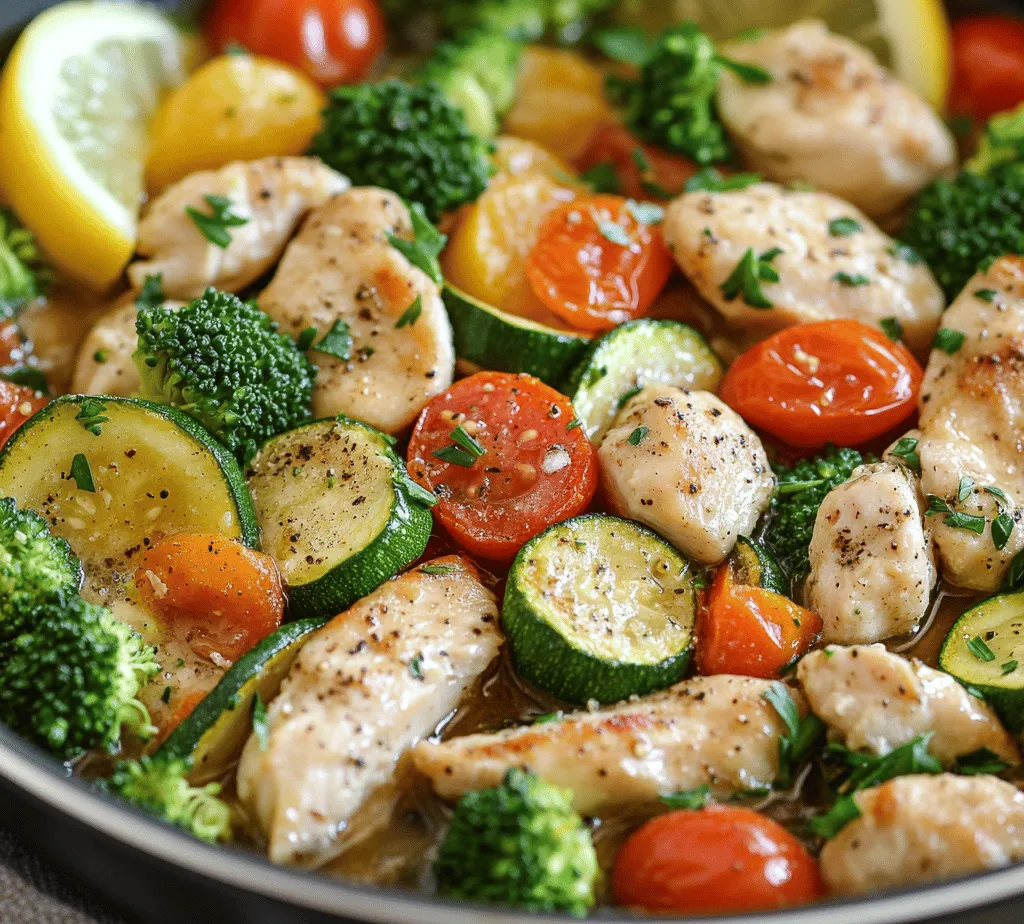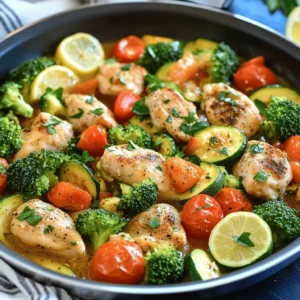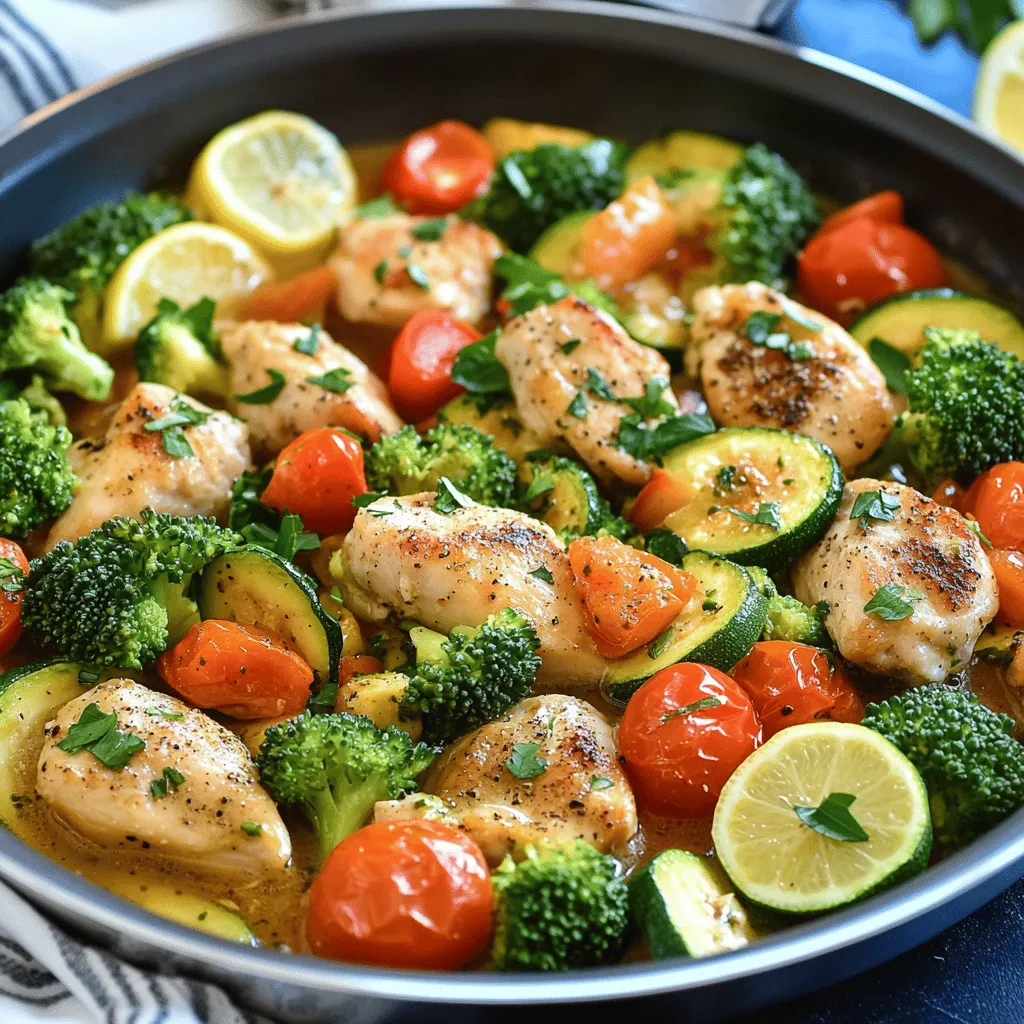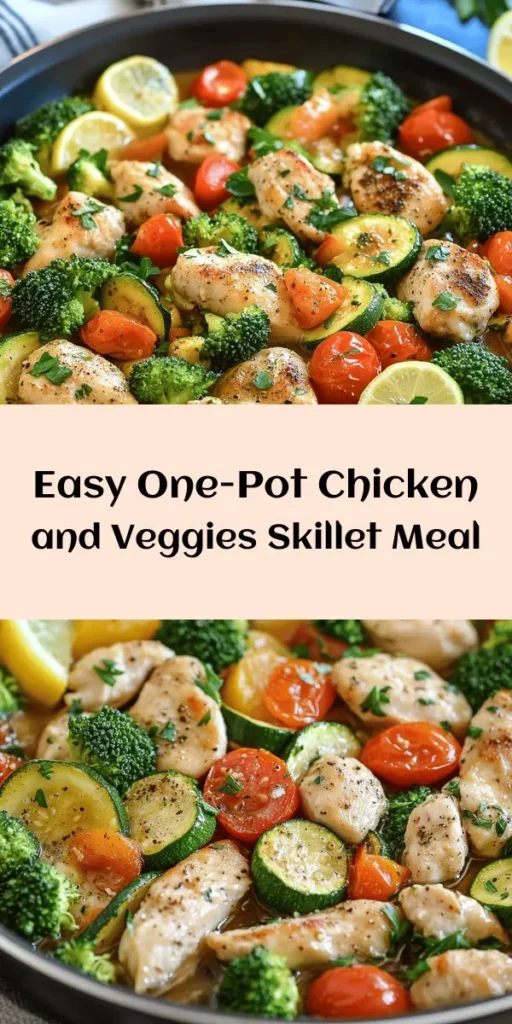Introduction
In today’s fast-paced world, the appeal of one-pot meals is undeniable. These culinary gems offer the perfect solution for busy families and individuals looking for quick, nutritious, and flavorful dishes without the hassle of extensive cleanup. Among the numerous one-pot recipes that have gained popularity, the One Pot Chicken and Vegetables Skillet stands out as a delectable choice that combines convenience with health. This dish not only delivers a satisfying meal but also showcases the vibrant colors and flavors of fresh ingredients.
Cooking with fresh ingredients transforms an ordinary meal into an extraordinary experience, and the One Pot Chicken and Vegetables Skillet epitomizes this philosophy. It allows you to enjoy a hearty dish that’s rich in nutrients and bursting with flavor, all while simplifying the cooking process. With just one skillet required, you can create a wholesome dinner that minimizes both preparation time and cleanup.
Understanding One-Pot Meals
Definition and Characteristics of One-Pot Meals
One-pot meals are precisely what they sound like: meals that are prepared in a single pot or pan. This cooking method streamlines the culinary process, allowing you to combine various ingredients into one harmonious dish. Typically, one-pot meals consist of a protein source, a variety of vegetables, and grains or starches, all cooked together to create a complete meal.
Advantages of One-Pot Cooking
One of the most significant advantages of one-pot cooking is time efficiency. With the ability to chop, sauté, and simmer all within one vessel, you significantly reduce the time spent in the kitchen. This efficiency is especially beneficial for busy weeknights when you want to prepare a nutritious meal without spending hours in the kitchen.
Additionally, one-pot meals require minimal cleanup. With fewer dishes to wash, you can spend more time enjoying your meal and less time scrubbing pots and pans. This simplicity is a game changer for many home cooks who appreciate the ease of preparing a full meal without the post-cooking chaos.
Flavor enhancement is another key benefit of one-pot meals. As ingredients cook together, their flavors meld, creating a rich and satisfying taste profile that is hard to achieve when cooking components separately. This method also allows for the infusion of spices and seasonings throughout the dish, resulting in a cohesive and flavorful experience with each bite.
The Popularity of One-Pot Recipes in Modern Cooking
The rise in popularity of one-pot recipes can be attributed to several factors. With the increasing trend of health-conscious eating and meal prepping, more home cooks are looking for ways to incorporate fresh ingredients into their diets without sacrificing convenience. One-pot meals fit perfectly into this narrative, allowing for flexibility in ingredient choices while ensuring a balanced meal.
Moreover, the emergence of social media and food blogging has propelled the visibility of these recipes. Platforms like Instagram and Pinterest are overflowing with visually appealing one-pot meals, inspiring home cooks to replicate these dishes in their own kitchens. The One Pot Chicken and Vegetables Skillet, in particular, has garnered attention for its vibrant colors and hearty ingredients, making it a favorite among food enthusiasts.
Nutritional Benefits of the Ingredients
When creating a One Pot Chicken and Vegetables Skillet, the focus is not just on convenience but also on the nutritional benefits of the ingredients involved.
Overview of the Health Benefits of Chicken as a Lean Protein Source
Chicken is a popular choice for many home cooks, and for good reason. As a lean protein source, it provides essential amino acids that are vital for muscle repair, immune function, and overall health. Additionally, chicken is relatively low in fat compared to other protein sources, making it suitable for a variety of dietary preferences.
Discussion on the Nutritional Value of Vegetables Used in the Recipe
The inclusion of vegetables in the One Pot Chicken and Vegetables Skillet not only enhances the flavor and texture of the dish but also boosts its nutritional profile. Here’s a closer look at some key vegetables commonly used in this recipe:
Broccoli: Vitamins, Minerals, and Antioxidants
Broccoli is a powerhouse of nutrients, rich in vitamins C, K, and A, as well as folate and fiber. This cruciferous vegetable is known for its antioxidant properties, which help protect the body from oxidative stress and inflammation. Including broccoli in your skillet adds a satisfying crunch and a wealth of health benefits.
Zucchini: Low-Calorie Content and Hydration Benefits
Zucchini is another fantastic addition to the One Pot Chicken and Vegetables Skillet. With its low-calorie content and high water content, zucchini is perfect for those looking to maintain a healthy weight while staying hydrated. It also provides essential nutrients like potassium, which aids in muscle function and heart health.
Bell Peppers: Rich in Vitamins A and C
Bell peppers, available in a variety of colors, are not only visually appealing but also packed with vitamins A and C. These vitamins are crucial for maintaining healthy skin, vision, and immune function. The sweet, crisp texture of bell peppers complements the other ingredients in the skillet, adding both flavor and nutrition.
Cherry Tomatoes: High in Lycopene and Vitamins
Cherry tomatoes are small but mighty when it comes to nutrition. They are high in lycopene, an antioxidant linked to various health benefits, including heart health and cancer prevention. Furthermore, cherry tomatoes are a great source of vitamins C and K, making them a fantastic addition to the One Pot Chicken and Vegetables Skillet.
The Role of Olive Oil in a Healthy Diet
In addition to the protein and vegetables, olive oil plays a vital role in this recipe. Known for its heart-healthy monounsaturated fats, olive oil is a staple of the Mediterranean diet and has been linked to numerous health benefits, including reduced inflammation and improved cardiovascular health. Using olive oil as the primary cooking fat not only enhances the flavor of the dish but also contributes to its overall healthiness.
Detailed Recipe Breakdown
Ingredient List with Potential Substitutes
To prepare your One Pot Chicken and Vegetables Skillet, you will need the following ingredients:
– Chicken: 1 pound of boneless, skinless chicken thighs (substitute with chicken breast or tofu for a vegetarian option)
– Broccoli: 2 cups, chopped (substitute with green beans or asparagus)
– Zucchini: 1 large, sliced (substitute with yellow squash)
– Bell Peppers: 1 cup, sliced (use any color or substitute with carrots)
– Cherry Tomatoes: 1 cup, halved (substitute with diced tomatoes)
– Olive Oil: 2 tablespoons (can replace with avocado oil or coconut oil)
– Garlic: 3 cloves, minced (fresh or pre-minced)
– Onion: 1 medium, diced (optional; can be omitted)
– Salt and Pepper: to taste
– Italian Seasoning: 1 tablespoon (or use a mix of dried basil, oregano, and thyme)
This ingredient list provides a flexible framework for your One Pot Chicken and Vegetables Skillet. You can easily customize it based on your pantry staples or personal preferences, ensuring that every cook can make this dish their own while enjoying the myriad benefits of one-pot cooking.
Stay tuned for the next part of this article, where we will dive into the step-by-step instructions to create this delightful dish, along with some tips for best results!

Preparation Steps with a Focus on Technique and Timing
To create a flavorful One Pot Chicken and Vegetables Skillet, preparation is key. Start by ensuring that all your ingredients are prepped and ready to go before you begin cooking. This not only speeds up the cooking process but helps maintain the integrity of each component in the dish.
1. Prep Your Ingredients:
– Cut the chicken into uniform pieces to ensure even cooking. Chicken thighs are recommended for their flavor and juiciness, but boneless chicken breasts work well too.
– Chop your vegetables—such as bell peppers, zucchini, carrots, and broccoli—into bite-sized pieces. Uniform sizes allow for even cooking.
– Mince garlic and onion finely to release their flavors effectively.
2. Timing is Key:
– Begin by heating your skillet over medium-high heat. This will allow for a good sear on the chicken, locking in moisture.
– Once the skillet is hot, add a high smoke point oil, like olive or vegetable oil, ensuring even coverage across the pan.
– Cook the chicken first, allowing it to brown for about 5-7 minutes on each side. This process not only cooks the meat but also adds a golden crust that enhances flavor.
Importance of Seasoning and Flavor Layering in the Cooking Process
Seasoning is crucial in elevating the flavors of your One Pot Chicken and Vegetables Skillet. Start with a generous pinch of salt and pepper while cooking the chicken. This helps build a flavor base that will permeate the entire dish.
After browning the chicken, add the garlic and onion to the skillet, allowing them to sauté for 2-3 minutes until fragrant. This layering of flavors is essential; the moisture released by the vegetables will deglaze the pan, lifting the flavorful bits stuck to the bottom—often referred to as “fond”—and infusing your dish with depth.
Next, introduce the chopped vegetables, seasoning them with additional salt, pepper, and your choice of herbs (like thyme or rosemary) to enhance their natural sweetness. The goal is to build on flavors throughout the cooking process, making each step impactful.
Cooking Techniques and Tips
Sautéing and Its Impact on Flavor
Sautéing is a cooking technique that involves cooking food quickly in a small amount of oil over relatively high heat. This method is particularly effective for your chicken and vegetables, as it allows for caramelization, which enhances the dish’s overall flavor profile. Keep the ingredients moving in the pan to avoid burning while allowing them to develop a nice color.
Tips for Ensuring Chicken is Cooked Properly
To ensure that your chicken is perfectly cooked, use a meat thermometer to check for doneness. Chicken should reach an internal temperature of 165°F (75°C) to be safe for consumption. Avoid cutting into the chicken to check for doneness, as this can cause juices to escape, leading to dry meat.
Achieving the Perfect Texture for Vegetables
When cooking vegetables, timing is crucial. Add heartier vegetables, like carrots and broccoli, first, as they take longer to cook. Follow with softer vegetables, like zucchini and bell peppers, which should only need a few minutes to become tender yet maintain a slight crunch. This technique ensures the vegetables are cooked to perfection, enhancing both flavor and texture.
The Significance of Simmering for Flavor Development
After the chicken and vegetables have been sautéed, introduce broth or water to the skillet. Bring the mixture to a simmer, which allows the flavors to meld beautifully. Simmering helps to soften the vegetables while ensuring that the chicken remains juicy and tender. Aim for a gentle simmer rather than a rolling boil to maintain the dish’s integrity.
Serving Suggestions
To elevate your One Pot Chicken and Vegetables Skillet, consider these serving suggestions:
– Pairing with Sides: This dish is versatile enough to be served on its own or with sides. Quinoa or brown rice are excellent options, as they absorb the flavorful juices from the skillet. Alternatively, crusty bread can provide a satisfying way to soak up the juices.
– Presentation Tips: For an appealing presentation, serve the skillet directly from the pan, garnished with freshly chopped herbs. This not only adds color but also a burst of fresh flavor. If serving on plates, consider arranging the chicken and vegetables in a visually pleasing manner, perhaps stacking or layering the components.
– Optional Garnishing Techniques: Brighten the dish with a sprinkle of lemon zest or a squeeze of fresh lemon juice just before serving. This adds a refreshing touch that complements the savory notes of the chicken and vegetables.
Storing and Reheating Leftovers
Best Practices for Storing One-Pot Chicken and Vegetable Skillet Leftovers
To store leftovers, allow the dish to cool completely before transferring it to an airtight container. Properly stored, your skillet meal can last in the refrigerator for up to 3-4 days. For longer storage, consider freezing the dish in a freezer-safe container, where it can last up to three months.
How to Reheat Without Losing Flavor and Texture
When reheating, aim to preserve the dish’s original flavor and texture. For stovetop reheating, place the skillet over low heat and stir occasionally, adding a splash of broth or water if needed to prevent drying out. If using a microwave, cover the dish to maintain moisture and heat in short intervals, stirring between.
Suggestions for Incorporating Leftovers into Other Meals
Leftovers can serve as a base for a variety of meals. Consider shredding the chicken and adding it to salads for a protein boost or mixing it with pasta and a light sauce for a quick meal. You can also use the leftovers as a filling for wraps or tacos, enhancing their versatility.
Conclusion
The One Pot Chicken and Vegetables Skillet is a testament to the beauty of simple, healthy cooking. Its ease of preparation makes it ideal for busy weeknights, while its abundance of flavors and nutrients ensures that your family enjoys a wholesome meal.
This recipe invites creativity, encouraging you to experiment with different vegetables or spices based on what’s in season or available in your pantry. Whether you choose to stick to the classic combination or introduce new elements, this dish is poised to become a family favorite.
Quick, healthy meals that cater to busy lifestyles are invaluable, and the One Pot Chicken and Vegetables Skillet perfectly embodies that philosophy. It is not only satisfying but also a nourishing option that can be enjoyed by the whole family. Embrace the versatility of this recipe and make it your own, ensuring that it remains a staple in your culinary repertoire.



